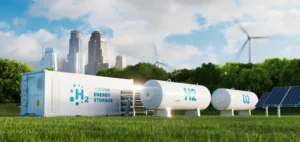In the United States, the production of green hydrogen, based on the electrolysis of water fuelled by renewable energies, is developing within an increasingly demanding framework.
Under the Inflation Reduction Act, the federal government provides tax credits (45V) to encourage the production of low-carbon hydrogen.
However, the conditions imposed to obtain these credits represent a major obstacle for players in the sector.
These include the obligation to combine hydrogen production with renewable energy consumption on an hourly basis, a local sourcing requirement, and the use of new energy installations.
These constraints are designed to ensure that the hydrogen produced is truly green, but they introduce additional complexity into project implementation. Hydrogen producers, especially those connected to power grids, now have to compete with energy-consuming businesses such as data centers, which do not have to comply with these same rules.
This puts them at a competitive disadvantage when it comes to accessing renewable energies.
Competition for access to renewable energies
Competition for access to renewable energies is intensifying in several states, including California, Oregon and Washington.
These regions, which actively encourage the production of low-carbon hydrogen, evaluate the carbon footprint of each project.
To obtain tax incentives, producers must prove that their electricity comes from renewable sources.
This requirement creates a real battle for access to these resources, particularly in the face of energy-intensive sectors such as technology giants and data centers, which absorb massive amounts of electricity.
Data centers in particular, whose numbers continue to grow with the expansion of artificial intelligence and cloud computing technologies, require huge amounts of energy.
This competition for available electricity weighs heavily on green hydrogen projects, especially those dependent on electricity grids.
The development of hydrogen projects has to contend with rising costs and increasingly long interconnection times.
This situation makes so-called “off-grid” hydrogen projects even more attractive, where producers develop their own energy facilities, thus avoiding direct competition with other users of renewable electricity.
Another major obstacle for green hydrogen projects is the traceability of the electricity used.
The new rules imposed by the Inflation Reduction Act require renewable electricity consumption to be tracked in real time, on an hourly basis.
This means that producers have to prove that the energy they use is green at the very moment they produce hydrogen.
This hourly traceability represents a technological challenge, as few systems are currently able to certify the origin of energy with such precision.
Only the PJM-GATS platform in the USA offers hourly tracking of renewable energy certificates, making access to tax credits even more complex for producers.
For grid-connected projects, this requirement adds a further level of difficulty.
Indeed, it is often impossible to guarantee that electricity drawn from the grid comes exclusively from renewable sources, especially in regions where the supply of green energy is already saturated by demand.
Challenges and prospects
Faced with these challenges, some market players are adopting alternative solutions.
Matt McMonagle, CEO of NovoHydrogen, explains that his company favors a model where it develops its own renewable energy sources, connected directly to its electrolyzers.
This approach guarantees the traceability of the electricity used, and frees the company from the constraints of competing for renewable energies via public grids.
However, for other NovoHydrogen projects, a connection to the grid remains necessary, not least because of the large quantities of energy required for hydrogen production.
In other cases, companies such as H2B2 Electrolysis Technologies are developing strategies aimed at vertically integrating their activities.
This gives them greater control over their renewable energy supplies, while optimizing production costs.
However, the hourly tracking of renewable electricity remains a major challenge, especially for projects located in regions where tracking infrastructures are not yet in place.
The pressure on US energy grids is only increasing.
According to projections, business needs for renewable energy are expected to require up to 19 GW of additional capacity by 2035.
This massive demand, fuelled by the electrification of transport and the rise of new technologies, further complicates access to energy for hydrogen projects.
For hydrogen producers, the rise of these competitors represents a considerable challenge.
The capacity of grids to supply clean energy in sufficient quantities is becoming increasingly limited, requiring innovative supply strategies to secure long-term energy resources.






















